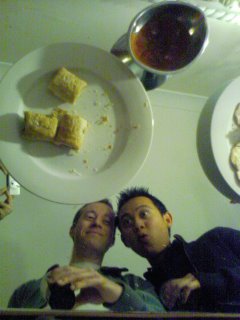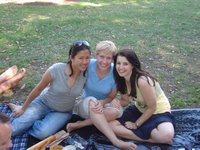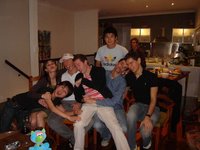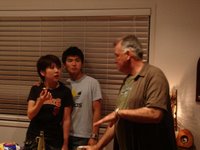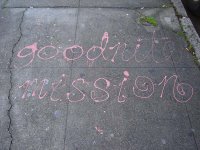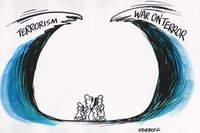mood: content like a kitten - 'a salt and battery' for dinner.
state of mind: bludge night tonight.
tune: phoenix "it's never been like that" album - this shit is really cool!!it's time for some fun. med is slowly sliding into a neurology block, the final module for the year. this can't happen fast enough for me! it feels so damn good to be back in territory that is not just familiar, but comfortable to boot. gastro and cardiology were cool, but neuro is where my heart is. to celebrate the official entry into the neurology block on monday, i am writing this blog entry.
this type of thing takes me straight back to the good old days of journal club with prof. jack pettigrew. this man rocks, and the journal clubs he held in my neuro courses were about 20% work, 80% "stories around the campfire", just how most learning ought to be.
take a look at his website for some fun games with interhemispheric switching in your brain, under the "perceptual rivalry demonstrations" link.
http://www.uq.edu.au/nuq/jack/jack.html
now, have a look at the following image...
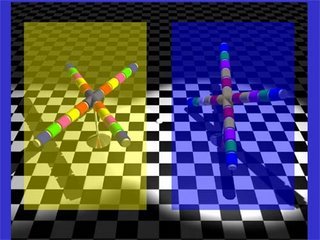
would you believe that the middle part of each of the two crosses is the same colour? the middle part on the cross on the left appears blue right? and on the right, the same part appears yellow does it not? but they are the same colour. don't believe me? open photoshop and see for yourself. they are the exact same colour!
ok, big deal, an optical illusion. now the next image is where it all gets a little more applied, and relevant to everyday life, especially in the jungle, or on the savannah, or in the african lake margins, or wherever else has been surmised to have been the cradle environment for the descent of man.
on the following diagram, i once gave a lengthy presentation.
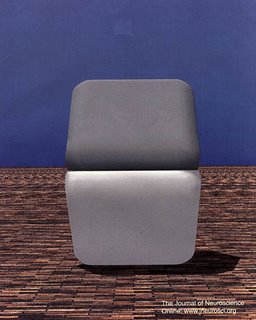
the area above the midline of the stone in the diagram, and the area below it, are identical in tone. once again, if you don't believe me, plug it into photoshop.
it is quite clear to the occipital cortex and other brain regions devoted to visual processing that the two parts of the diagram are a different colour: the area on top is notably darker than the area below. however, photoshop disagrees. the supreme judge of colour, it is well aware that they are identical. so why might we see, or fail to see as it might be, such a phenomenon.
but more honestly, who cares! well, our brain certainly doesn't, that's a certainty. of what benefit is it to an individual to determine precisely what colour is what, when the consequences are of little difference? to illustrate this point to my audience at my presentation, i used three citrus fruits. one, an orange, another, a mandarin, and the third was a rather flat looking orange, more closely resembling a mandarin. my audience was unable to tell that the third fruit was an orange, thinking it might be a mandarin, or, perhaps relying on the knowledge gained thus far that i was presenting
different varieties of citrus, a tangerine. but the point was: if you were really hungry, who cares! just eat it. mandarin, orange, pear, all are fruit, and all would go some way to satiate a hunger.
to place this in a wider context, be aware that the brain actually throws out more than 98% of the stimuli that it is presented with. since i sat down at my computer, numerous cars, and the odd bus have driven by, but in all honesty, the only one i have heard was the one that drove by as i typed this sentence. does that mean all of the others have failed to stimulate the inner hair cells of my ear? likewise, i have been wearing clothes since i dryed myself after a shower. but save for the first few seconds, and when i have gotten up and moved, my brain has registered few messages from my skin to tell me there is fabric touching it. does that mean my clothes have failed to stimulate the pacinian corpuscles in my dermis? of course bot, but to centrally register all of the stimuli that our peripheral senses and eyes detect would be mentally overwhelming, and pointless to say the least. (by the way, a bus just drove by!)
in the instance of my presentation of fruit to my audience, if they were awfully hungry, their brains wouldn't be interested in citrus ambuguity. under all circumstances (except for my talk), nor would they be when presented with such stimuli as given in the above diagrams. the idea central to this theory, nutted out largely by prof. dale purves, is that the sum of all previous visual stimuli will influence the perception of what is seen at any given moment - "what we see at any moment is, quite literally, always predicated on the probability distribution of the possible sources of the retinal stimulus." if the brain, based on the multitudes of previous occasions when it has been presented with similar stimuli, perceives something as probably dark in colour, then for that moment, it will do only good, and little harm, to perceive it as nothing else. or, if it looks like a mandarin, for all the good it will do me, it probably is.
how is this phenomenon applied day to day? as i look at the wall behind my laptop, the desklamp has cast many shadows on it. some are darker than others, depending on whether or not additional light has been cast upon the same area. i can look at the curtain hanging from the wall on the other side of the room. as the fabric follows a path of flowing in and out of loose folds, some areas are illuminated by the ceiling light, others are not, with a myriad of intonations of darker and lighter between the two. the curtain is the same colour, end to end, but the eye perceives some areas of beige, others of chocolate brown.
these visual experiences are but two of the millions that influence the outcome of my brains perception of any similar stimuli it might subsequently receive. our brain might ask itself, is this a highly reflective surface in weak illumination, or a weakly reflective one in strong illumination. the judgement it makes will likely be strongly under the influence of past experiences.
is it a mandarin, or an orange? who cares, i'm hungry. is it light grey next to a dark grey surface, or dark grey next to a really dark grey surface. who cares, i have better things to do with my attention, i'll trust what it has always been in the past when it has looked this way.
recalling the fact that interneurons in the central nervous system connect all of our sensory modalities many times over, as well as our visceral affectors, emotional circuitry, and many other areas, one can begin to imagine the complexity involved in perceiving and responding to the outside world.
one more for the hell of it. the squares on the board at A and B are the same tone. but you believe me right? no need to open photoshop, and waste valuable attention that might be better spent keeping an eye out for a potential predator, or amassing wealth with which to impress a potential mate...






